Features of proper storage of potatoes: from A to Z
In early autumn, many housewives buy several sacks of potatoes in reserve, and gardeners are preparing the harvested crop for winter storage. Despite the fact that potatoes are very picky about wintering conditions, it is not difficult to keep them until mid-winter. We will tell you in detail how to properly store potatoes and where to keep them.
The content of the article
Optimal conditions for storing potatoes in winter
Long-term storage requires certain environmental conditions.
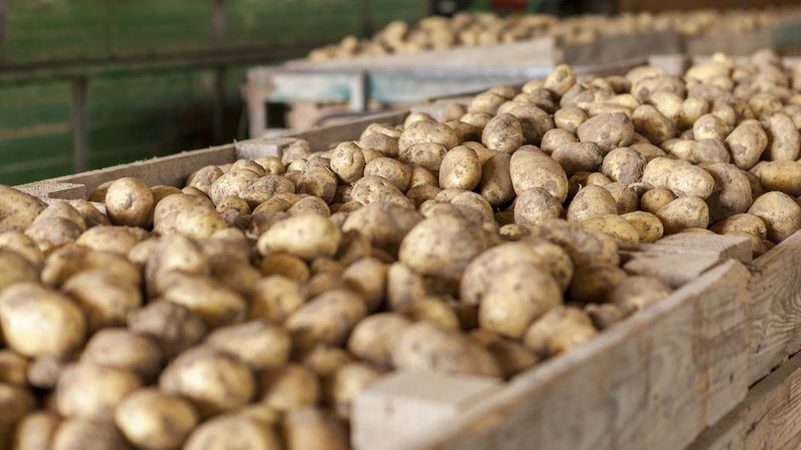
Temperature
Long-term storage of tubers ensures temperature within + 2 ... + 4 ° С, which allows you to preserve the taste and appearance of vegetables for several months.
Lowering the temperature to 0 ° С promotes the conversion of starch contained in potatoes into sugar, and the vegetable acquires a sweetish taste. With a stronger and more constant temperature drop, it freezes and deteriorates.
Warming "awakens" the potatoes, and already at + 7 ° C, the tubers begin germinate.
Humidity
The optimum level of air humidity for storing vegetables is 70-85%.
An increase in humidity will lead to mold, disease, and decay. Lowering - to the softness and flabbiness of the tubers.
Illumination
Potatoes are stored exclusively in a dark room. The light causes the tubers to turn green, which is associated with the production of toxic solanine.
Storage periods
Different varieties of vegetables have different shelf life. Early ripe potatoes in ideal conditions are up to 2-3 months. Mid- and late-ripening varieties with yellow flesh are stored for the longest.
The storage duration is influenced by the size and condition of the tubers:
- the shortest shelf life for small, damaged and cut tubers;
- medium shelf life (until midwinter) for large, overgrown tubers;
- medium-sized undamaged tubers are stored for a long time.
The shelf life of the vegetable will increase if the tubers are poured:
- crushed garlic;
- onion peel;
- oven ash.
Potatoes will not rot or spoil if you transfer the tubers with leaves and plants containing bactericidal substances (phytoncides), for example:
- rowan leaves;
- elderberry;
- fern;
- tobacco;
- bitter wormwood;
- crushed garlic;
- pine or spruce branches.
Long storage of tubers is achieved by sprinkling them with chalk, shavings, straw or cut paper.
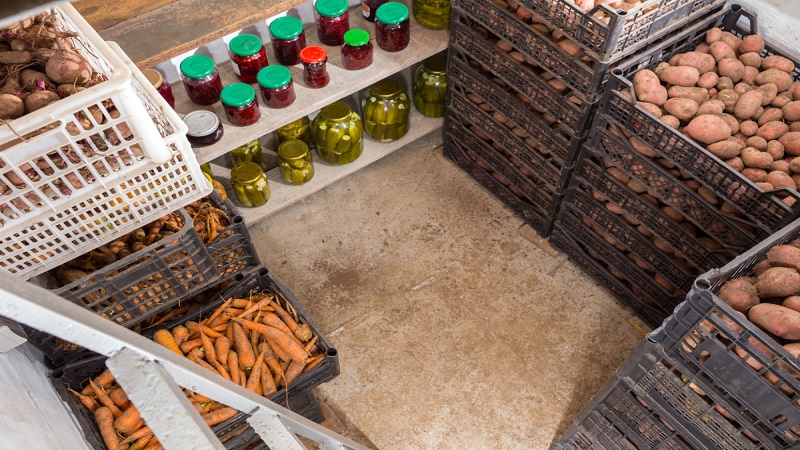
Neighborhood
Most vegetables are not recommended to be mixed together, but some of them only benefit from joint storage.
One of the most successful solutions is to arrange the beets in boxes on top of the potato tubers. Beets will protect the tubers from the cold and prevent fungal infections by absorbing excess moisture.
Potatoes are also well stored, interlaced with ginger root.
Preparing potatoes for storage
Tuber preparation to long-term storage consists of two stages.
Treatment
Purpose: to exclude "underground" diseases (for most microorganisms, ultraviolet light is harmful), to allow the tubers to mature and overgrow small damage.
Freshly dug potatoes are left to dry for 2-3 hours in the sun, after which they are transferred to the shade under a canopy and left for 2-3 weeks.
By the end of the treatment period, the temperature is gradually reduced to + 2 ... + 4 ° C.
Important! During the entire treatment period, potatoes should not be exposed to moisture. It is not washed and carefully protected from rain and dew.
During this period, the tubers are sorted and examined several times, diseased and affected vegetables are removed.
Cooling
Purpose: identification of latent diseases.
Dried potatoes are placed in a cool room (cellar, basement) at a temperature of + 2 ... + 4 ° C for 1 month. It is recommended to arrange vegetables in 1-2 layers for easy access.
At least once a week, the tubers are examined, the damaged ones are removed.
Do I need to process tubers before storage
Potatoes that have passed the preparation stages do not need additional processing. To exclude diseases, it is sprayed with antifungal biological products - "Baktofit" or "Fitosporin".
Tuber reaction to temperature
Maintaining the temperature regime is the main condition for long-term preservation.
Will potatoes freeze at minus 1
Temperature -1 ° C is dangerous for tubers only with regular and prolonged exposure... If this value is rare and short-lived, there will be no noticeable consequences.
Minimum temperature for storing potatoes
If the air temperature has not dropped below 0 ° C, the potatoes will not freeze. And not a single variety of vegetables can withstand minus values.
Frozen potatoes are suitable for eating, despite the sweetish taste.
Where can you store potatoes
Storage space for potatoes are selected in many ways.
In the pantry
The main plus of storage in the closet is easy and quick access to vegetables at any time.
External storage rooms located in non-residential premises (garages, annexes) are organized according to the principle of basements and cellars: they provide the required temperature and humidity.
In the basement

The basement, located above the house, protects it from freezing in winter, but heats up quickly when it gets warm. Store potatoes in the basement in bags boxes or grids.
In the cellar
A cellar with a constant temperature of about + 4 ° C is the most practical and popular way of storing crops.
Vegetables in the cellar are mainly stored in boxes or in bulk.
For the winter, the cellar is insulated, and the potatoes are covered with burlap.
On the balcony or loggia

Storing potatoes on balcony or loggias is very popular - not everyone has additional premises for harvesting, and a small amount of potatoes should always be at hand.
The temperature on the glazed balcony is close to ideal, but ventilation and thermal insulation are not provided there.
The main storage method is in boxes or bags, covered with a blanket or other warm clothing.
Heated and unheated balcony
A heated balcony is more convenient for storage if the air temperature on it is close to the desired values. If the air warms up to + 7 ° C and above, the potatoes will sprout.
On an unheated balcony at low winter temperatures in the region, insulated storage will be required. If the temperature rarely drops below 0 ° C, when freezing, it is enough to cover the potatoes with a warm blanket.
Glazed or non-glazed balcony
A glazed balcony with adequate ventilation is preferred for storing tubers, provided they are not exposed to direct sunlight.
If the balcony is not glazed, there is a high probability of moisture (rain or snow) getting on the vegetables and freezing them.
In a refrigerator
It is not recommended to store potatoes in a regular refrigerator - it will acquire a sweetish taste.
But the use of a "Khrushchev" refrigerator (a cabinet under the window) is the right decision: the air temperature in such a cabinet is always lower than in an apartment, but higher than outside.
The main disadvantage of such a storage place is its small volume.
In the corridor
The corridor in the apartment is not suitable for storing potatoes due to the high temperature - the tubers will begin to rot.
In a hole in the ground
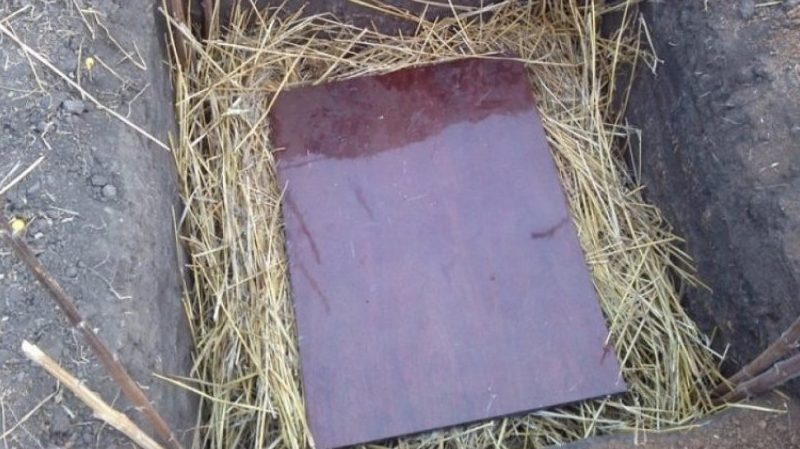
The method is suitable for storing surplus potatoes until spring with a very large yield. The bottom of the pit is covered with straw, tubers are put on it, straw again, then covered with boards and covered with land... In case of cold snaps, additional layers of straw and earth are poured on top. Of the minuses - difficult access to the product (you need to dig it out).
In the trenches
Potatoes are stored in trenches, the need for which will not arise until mid-spring - early summer.
The potatoes are laid out in layers and sprinkled with damp earth at least 3 cm thick. When the temperature drops, straw and earth are poured on top.
In the pile

Burt is a trench, fenced on both sides by boards, between which potatoes are poured. A thick layer of straw (from 0.5 to 1 m), earth (40-70 cm) and heat-insulating material are placed on top.
In frosts, heaps are insulated with straw, snow or peat. When the temperature rises, the insulation is removed.
In the apartment
Potatoes are poorly stored in the apartment. How to keep potatoes indoors? Choosing places that will increase term its shelf life for at least 1-2 weeks:
- where it is cold - in front of the balcony, by the window, in the hallway;
- where it is dark - under the sink, in the closet;
- where there is free space - in special drawers of cabinets.
What and how to store potatoes
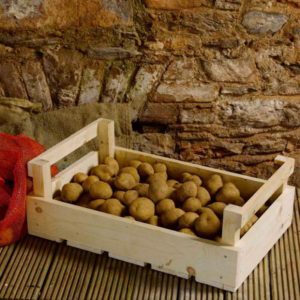
The selection of containers is of no less importance for the preservation of potatoes.
In wooden boxes
The most common storage method, providing adequate ventilation, easy access to the crop, and sorting of tubers in 10-12 kg portions that are easy to carry away.
The boxes should not stand on the floor or close to walls or to each other. The distance from the box to the floor and to the walls is at least 20 cm.
In plastic containers
Plastic storage facilities for vegetables are equipped with ventilation holes and have easy access to the contents. But potatoes are stored in such boxes for a short time - up to a month.
In heated drawers
An increasingly popular technological way of storing potatoes is a thermal container with a heating and temperature maintenance system. It has the shape of a box or a backpack with electrical insulation. It is easy to maintain and keeps the harvest even at -40 ° C.
In bags made of natural fabric
In addition to providing ventilation, burlap protects the potatoes from sunlight and greening. But it does not protect against frost, rain and snow.
In bulk
The easiest way to store, no additional cost.
The main conditions are not too high pile height and high-quality preparation of tubers: 1-2 rotten specimens caught in the middle of the pile will quickly spoil the entire crop.
In grids
The advantages of storing potatoes in nets are the low cost of the material, the ability to easily monitor the condition of the tubers, and inaccessibility to rodents if they are suspended high above the floor.
However, the netting does not protect the vegetable from frost and sunlight.
How to protect against moisture and freezing
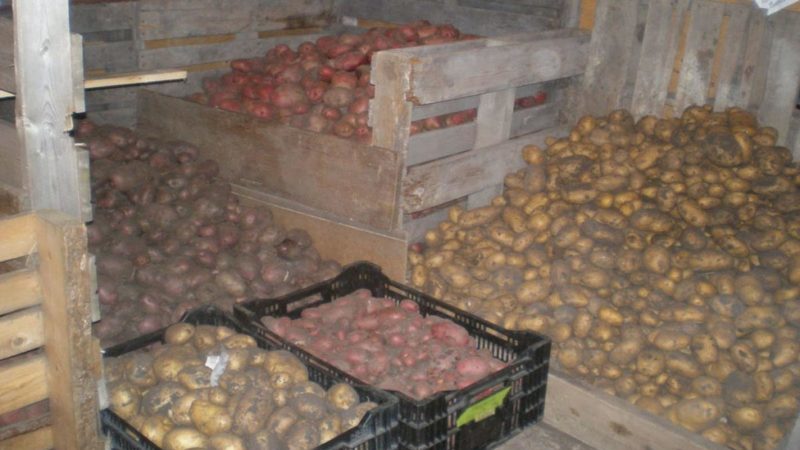
The storage room is pre-dried and disinfected with a concentrated solution of lime. Wooden boxes and shelves are treated several times with a strong solution of potassium permanganate and completely dried in the open air.
Excessive dampness is removed by a hood or vent and thermal insulation.
To reduce the moisture content of the room, a layer of lime and sand is laid on the floor, and the potatoes are covered with burlap or felt and covered with sawdust or straw.
How to prevent sprouting of potatoes during storage
Tubers begin to germinate when the temperature rises to + 7 ° C. Accordingly, the room temperature should not rise to this value.
Important! The room is ventilated mainly at night, cooled with air conditioner or covered with ice.
It is also believed that the germination process will stop if the tubers are mixed with mint leaves.
Common mistakes when storing potatoes
In the absence of experience in storing vegetables, housewives make the following mistakes:
- storage of potato varieties that are not intended for this - early maturing;
- storing damaged potatoes that can ruin half the crop;
- unwillingness to regularly sort out potatoes, rejecting rotten tubers;
- storing tubers with or next to fruits - potatoes germinate faster and fruits become "cottony".
Conclusion
Laying potatoes for storage is a laborious and time-consuming process, including the preparation of tubers, their careful examination and culling. This will preserve the harvest for long winter months in cellars and basements suitable for storage, modern automated thermo boxes on balconies, in bags and piles.